2024 FORD F650/750 adding oil
[x] Cancel search: adding oilPage 191 of 386
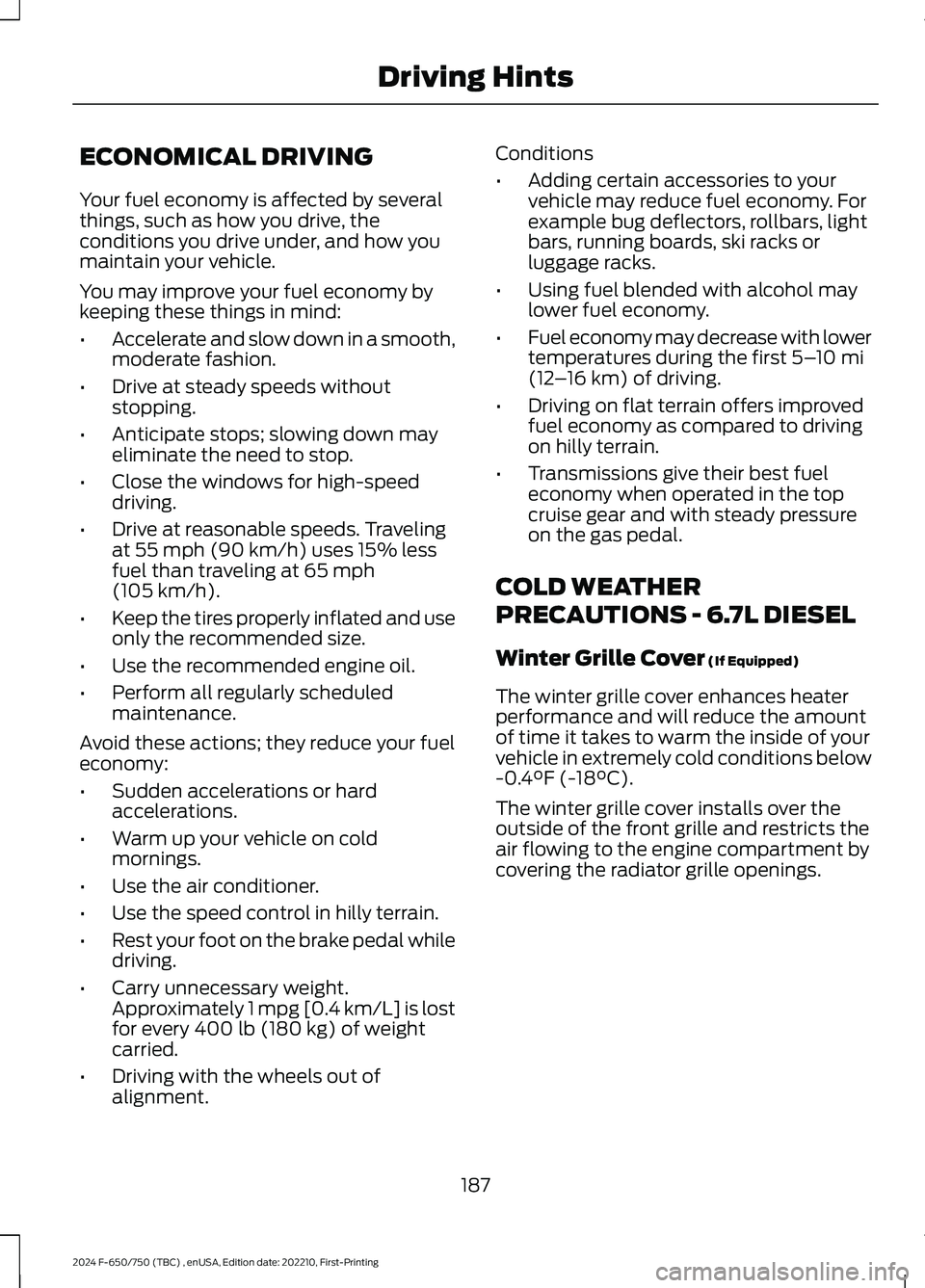
ECONOMICAL DRIVING
Your fuel economy is affected by severalthings, such as how you drive, theconditions you drive under, and how youmaintain your vehicle.
You may improve your fuel economy bykeeping these things in mind:
•Accelerate and slow down in a smooth,moderate fashion.
•Drive at steady speeds withoutstopping.
•Anticipate stops; slowing down mayeliminate the need to stop.
•Close the windows for high-speeddriving.
•Drive at reasonable speeds. Travelingat 55 mph (90 km/h) uses 15% lessfuel than traveling at 65 mph(105 km/h).
•Keep the tires properly inflated and useonly the recommended size.
•Use the recommended engine oil.
•Perform all regularly scheduledmaintenance.
Avoid these actions; they reduce your fueleconomy:
•Sudden accelerations or hardaccelerations.
•Warm up your vehicle on coldmornings.
•Use the air conditioner.
•Use the speed control in hilly terrain.
•Rest your foot on the brake pedal whiledriving.
•Carry unnecessary weight.Approximately 1 mpg [0.4 km/L] is lostfor every 400 lb (180 kg) of weightcarried.
•Driving with the wheels out ofalignment.
Conditions
•Adding certain accessories to yourvehicle may reduce fuel economy. Forexample bug deflectors, rollbars, lightbars, running boards, ski racks orluggage racks.
•Using fuel blended with alcohol maylower fuel economy.
•Fuel economy may decrease with lowertemperatures during the first 5–10 mi(12–16 km) of driving.
•Driving on flat terrain offers improvedfuel economy as compared to drivingon hilly terrain.
•Transmissions give their best fueleconomy when operated in the topcruise gear and with steady pressureon the gas pedal.
COLD WEATHER
PRECAUTIONS - 6.7L DIESEL
Winter Grille Cover (If Equipped)
The winter grille cover enhances heaterperformance and will reduce the amountof time it takes to warm the inside of yourvehicle in extremely cold conditions below-0.4°F (-18°C).
The winter grille cover installs over theoutside of the front grille and restricts theair flowing to the engine compartment bycovering the radiator grille openings.
187
2024 F-650/750 (TBC) , enUSA, Edition date: 202210, First-PrintingDriving Hints
Page 231 of 386
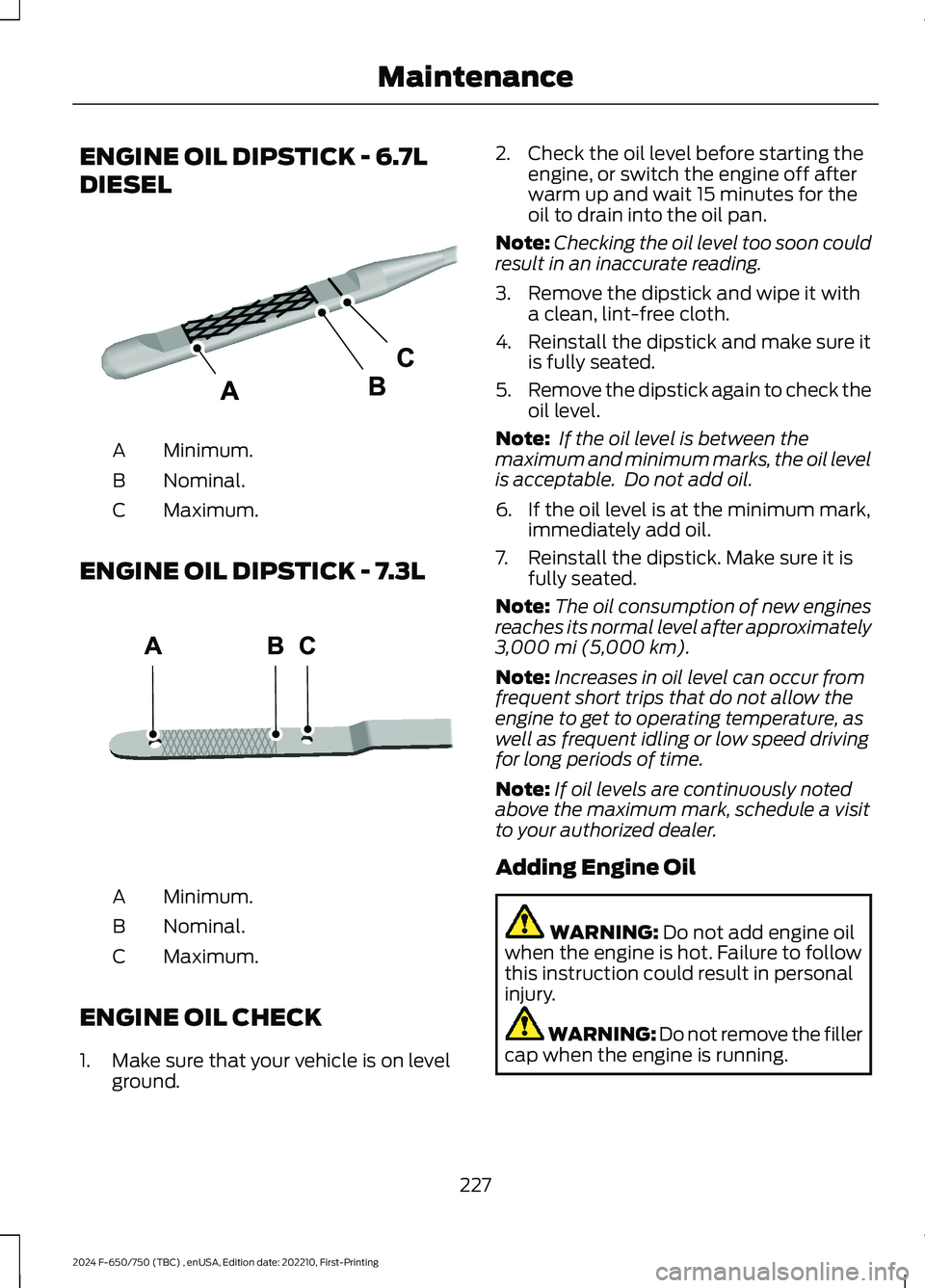
ENGINE OIL DIPSTICK - 6.7L
DIESEL
Minimum.A
Nominal.B
Maximum.C
ENGINE OIL DIPSTICK - 7.3L
Minimum.A
Nominal.B
Maximum.C
ENGINE OIL CHECK
1.Make sure that your vehicle is on levelground.
2.Check the oil level before starting theengine, or switch the engine off afterwarm up and wait 15 minutes for theoil to drain into the oil pan.
Note:Checking the oil level too soon couldresult in an inaccurate reading.
3.Remove the dipstick and wipe it witha clean, lint-free cloth.
4.Reinstall the dipstick and make sure itis fully seated.
5.Remove the dipstick again to check theoil level.
Note: If the oil level is between themaximum and minimum marks, the oil levelis acceptable. Do not add oil.
6.If the oil level is at the minimum mark,immediately add oil.
7.Reinstall the dipstick. Make sure it isfully seated.
Note:The oil consumption of new enginesreaches its normal level after approximately3,000 mi (5,000 km).
Note:Increases in oil level can occur fromfrequent short trips that do not allow theengine to get to operating temperature, aswell as frequent idling or low speed drivingfor long periods of time.
Note:If oil levels are continuously notedabove the maximum mark, schedule a visitto your authorized dealer.
Adding Engine Oil
WARNING: Do not add engine oilwhen the engine is hot. Failure to followthis instruction could result in personalinjury.
WARNING: Do not remove the fillercap when the engine is running.
227
2024 F-650/750 (TBC) , enUSA, Edition date: 202210, First-PrintingMaintenanceE249448 E250320
Page 338 of 386
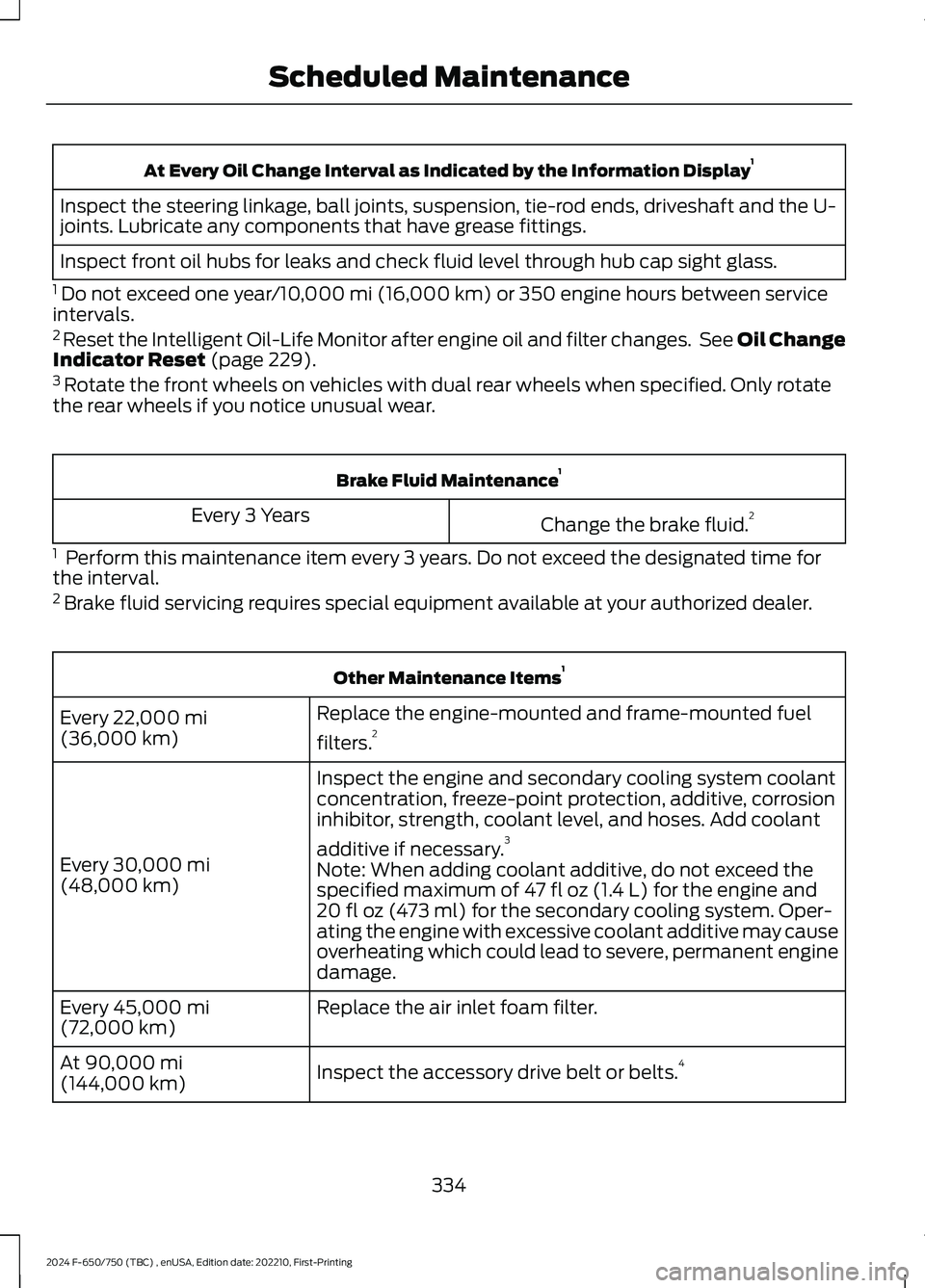
At Every Oil Change Interval as Indicated by the Information Display1
Inspect the steering linkage, ball joints, suspension, tie-rod ends, driveshaft and the U-joints. Lubricate any components that have grease fittings.
Inspect front oil hubs for leaks and check fluid level through hub cap sight glass.
1 Do not exceed one year/10,000 mi (16,000 km) or 350 engine hours between serviceintervals.2 Reset the Intelligent Oil-Life Monitor after engine oil and filter changes. See Oil ChangeIndicator Reset (page 229).3 Rotate the front wheels on vehicles with dual rear wheels when specified. Only rotatethe rear wheels if you notice unusual wear.
Brake Fluid Maintenance1
Change the brake fluid.2Every 3 Years
1 Perform this maintenance item every 3 years. Do not exceed the designated time forthe interval.2 Brake fluid servicing requires special equipment available at your authorized dealer.
Other Maintenance Items1
Replace the engine-mounted and frame-mounted fuel
filters.2Every 22,000 mi(36,000 km)
Inspect the engine and secondary cooling system coolantconcentration, freeze-point protection, additive, corrosioninhibitor, strength, coolant level, and hoses. Add coolant
additive if necessary.3
Every 30,000 mi(48,000 km)Note: When adding coolant additive, do not exceed thespecified maximum of 47 fl oz (1.4 L) for the engine and20 fl oz (473 ml) for the secondary cooling system. Oper-ating the engine with excessive coolant additive may causeoverheating which could lead to severe, permanent enginedamage.
Replace the air inlet foam filter.Every 45,000 mi(72,000 km)
Inspect the accessory drive belt or belts.4At 90,000 mi(144,000 km)
334
2024 F-650/750 (TBC) , enUSA, Edition date: 202210, First-PrintingScheduled Maintenance
Page 343 of 386
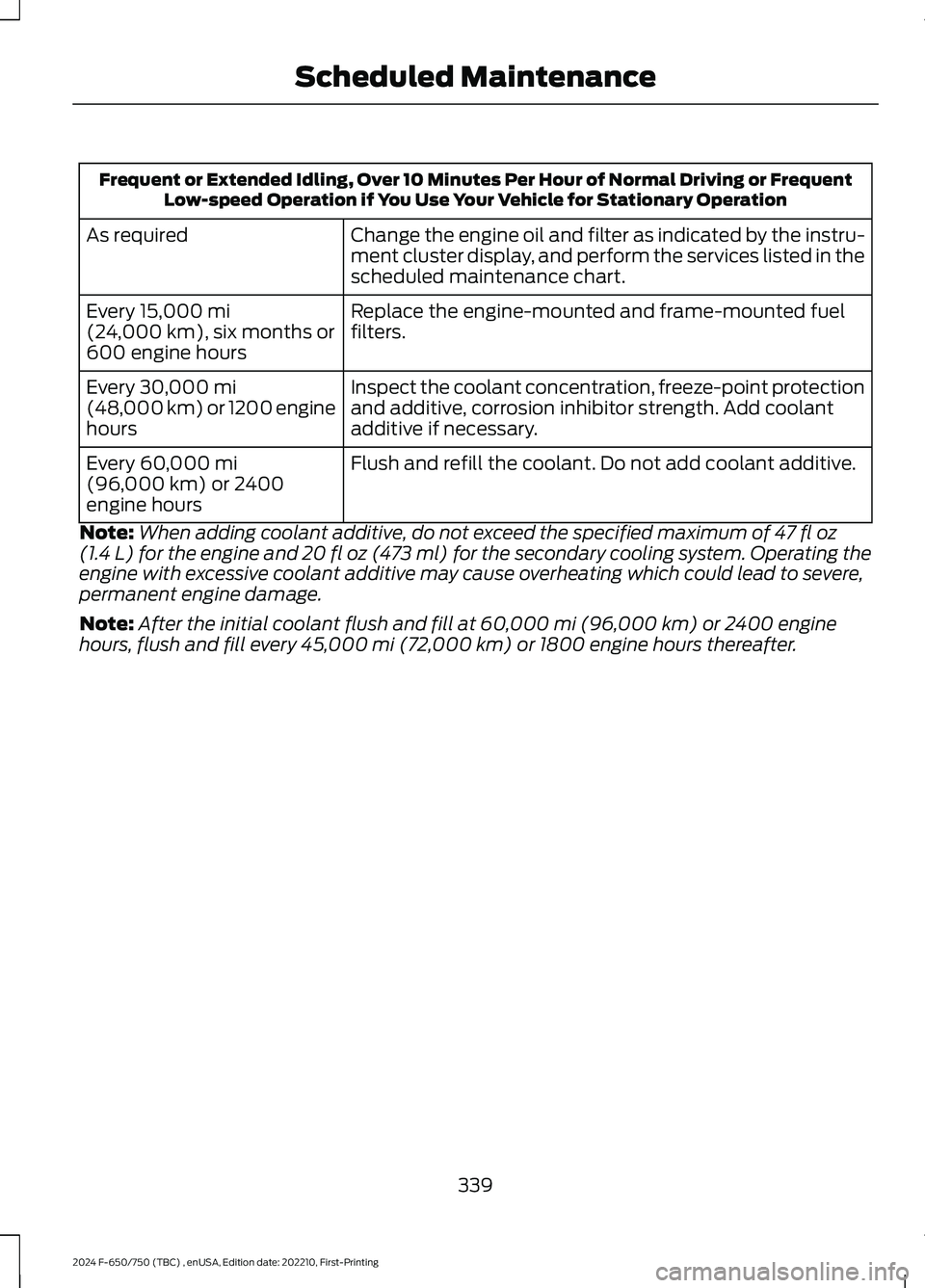
Frequent or Extended Idling, Over 10 Minutes Per Hour of Normal Driving or FrequentLow-speed Operation if You Use Your Vehicle for Stationary Operation
Change the engine oil and filter as indicated by the instru-ment cluster display, and perform the services listed in thescheduled maintenance chart.
As required
Replace the engine-mounted and frame-mounted fuelfilters.Every 15,000 mi(24,000 km), six months or600 engine hours
Inspect the coolant concentration, freeze-point protectionand additive, corrosion inhibitor strength. Add coolantadditive if necessary.
Every 30,000 mi(48,000 km) or 1200 enginehours
Flush and refill the coolant. Do not add coolant additive.Every 60,000 mi(96,000 km) or 2400engine hours
Note:When adding coolant additive, do not exceed the specified maximum of 47 fl oz(1.4 L) for the engine and 20 fl oz (473 ml) for the secondary cooling system. Operating theengine with excessive coolant additive may cause overheating which could lead to severe,permanent engine damage.
Note:After the initial coolant flush and fill at 60,000 mi (96,000 km) or 2400 enginehours, flush and fill every 45,000 mi (72,000 km) or 1800 engine hours thereafter.
339
2024 F-650/750 (TBC) , enUSA, Edition date: 202210, First-PrintingScheduled Maintenance
Page 344 of 386

Frequent Low-speed Operation, Consistent Heavy Traffic Under 25 mph (40 km/h) orLong Rush-hour Traffic
Change the engine oil and filter as indicated by the instru-ment cluster display, and perform the services listed in thescheduled maintenance chart.
As required
Replace the engine-mounted and frame-mounted fuelfilters.Every 15,000 mi(24,000 km), six months or600 engine hours
Inspect the coolant concentration, freeze-point protectionand additive, corrosion inhibitor strength. Add coolantadditive if necessary.
Every 30,000 mi(48,000 km) or 1200 enginehours
Flush and refill the coolant. Do not add coolant additive.Every 60,000 mi(96,000 km) or 2400engine hours
Note:When adding coolant additive, do not exceed the specified maximum of 47 fl oz(1.4 L) for the engine and 20 fl oz (473 ml) for the secondary cooling system. Operating theengine with excessive coolant additive may cause overheating which could lead to severe,permanent engine damage.
Note:After the initial coolant flush and fill at 60,000 mi (96,000 km) or 2400 enginehours, flush and fill every 45,000 mi (72,000 km) or 1800 engine hours thereafter.
340
2024 F-650/750 (TBC) , enUSA, Edition date: 202210, First-PrintingScheduled Maintenance
Page 345 of 386
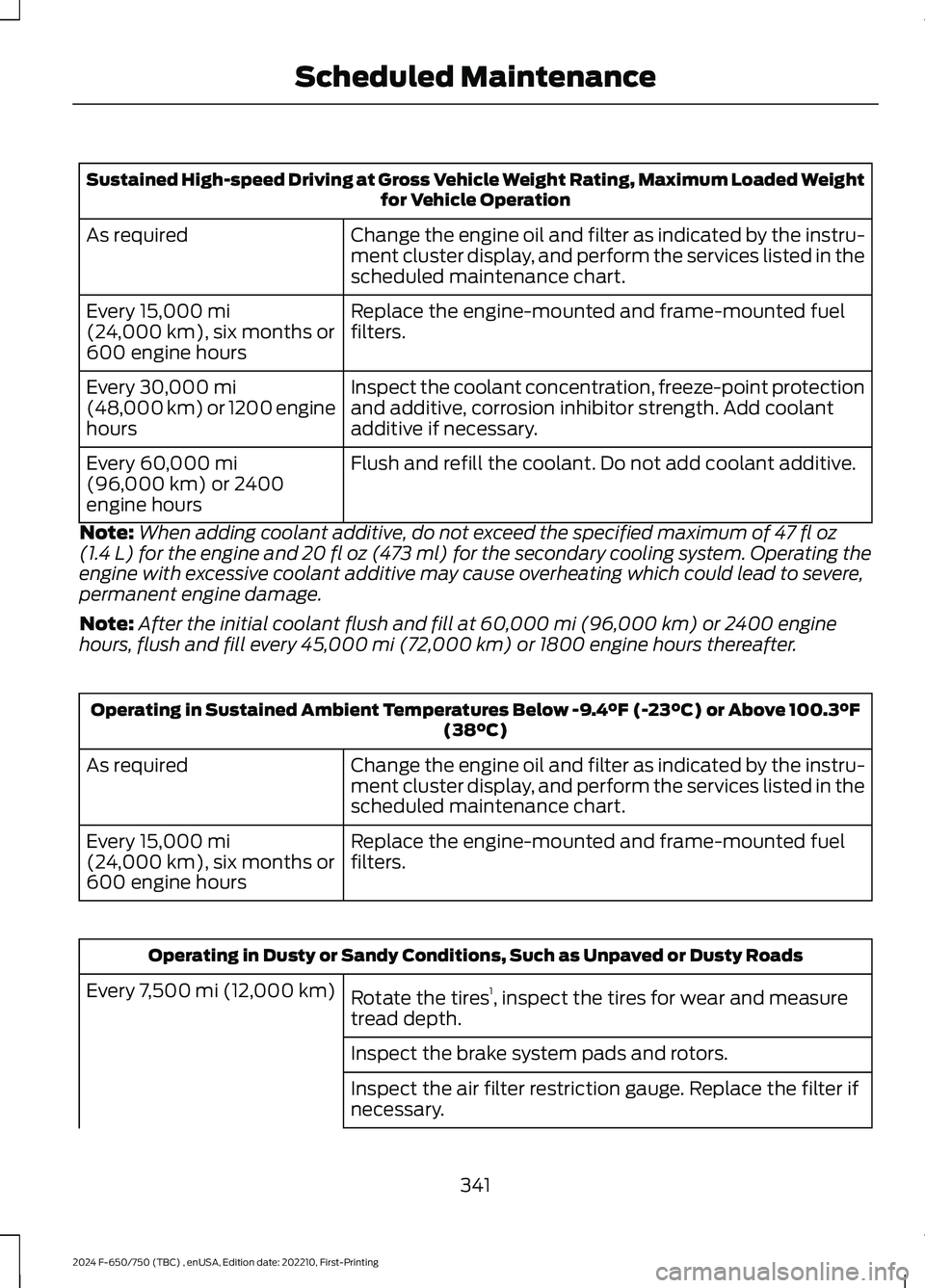
Sustained High-speed Driving at Gross Vehicle Weight Rating, Maximum Loaded Weightfor Vehicle Operation
Change the engine oil and filter as indicated by the instru-ment cluster display, and perform the services listed in thescheduled maintenance chart.
As required
Replace the engine-mounted and frame-mounted fuelfilters.Every 15,000 mi(24,000 km), six months or600 engine hours
Inspect the coolant concentration, freeze-point protectionand additive, corrosion inhibitor strength. Add coolantadditive if necessary.
Every 30,000 mi(48,000 km) or 1200 enginehours
Flush and refill the coolant. Do not add coolant additive.Every 60,000 mi(96,000 km) or 2400engine hours
Note:When adding coolant additive, do not exceed the specified maximum of 47 fl oz(1.4 L) for the engine and 20 fl oz (473 ml) for the secondary cooling system. Operating theengine with excessive coolant additive may cause overheating which could lead to severe,permanent engine damage.
Note:After the initial coolant flush and fill at 60,000 mi (96,000 km) or 2400 enginehours, flush and fill every 45,000 mi (72,000 km) or 1800 engine hours thereafter.
Operating in Sustained Ambient Temperatures Below -9.4°F (-23°C) or Above 100.3°F(38°C)
Change the engine oil and filter as indicated by the instru-ment cluster display, and perform the services listed in thescheduled maintenance chart.
As required
Replace the engine-mounted and frame-mounted fuelfilters.Every 15,000 mi(24,000 km), six months or600 engine hours
Operating in Dusty or Sandy Conditions, Such as Unpaved or Dusty Roads
Rotate the tires1, inspect the tires for wear and measuretread depth.
Every 7,500 mi (12,000 km)
Inspect the brake system pads and rotors.
Inspect the air filter restriction gauge. Replace the filter ifnecessary.
341
2024 F-650/750 (TBC) , enUSA, Edition date: 202210, First-PrintingScheduled Maintenance